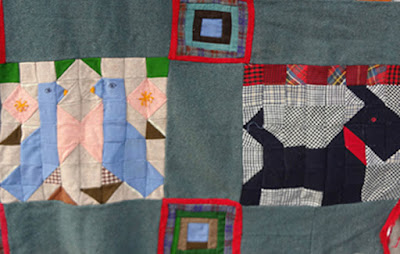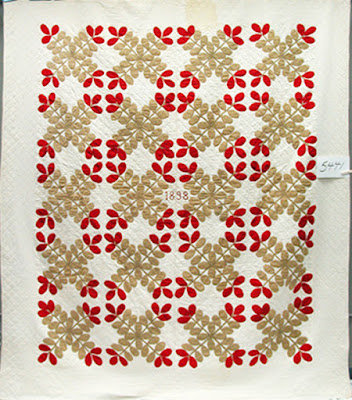A simple block of compound leaves...
many variations within its narrow definition---
Four repeating diagonal arms, crossed stems, simple leaf shapes repeated
In my
Encyclopedia of Applique two versions #5.54 and 5.55. For more about #5.55 see this post:
https://barbarabrackman.blogspot.com/2015/07/pattern-names-romance-revision.html
Another option has an empty center, a place for an inscription.
Mountain Laurel for Hospital Sketches by Mark Lauer
That's the one we're doing in the Hospital Sketches BOM this month. See a post here:
I might ink some kind of label in the center here.
Mary Jane Shoemaker, dated 1849, Virginia
from Jeffrey Evans Auctions
Another from Jeffrey Evans Auctions, just sold.
Jeanne Arnieri's reproduction #6 for Hospital Sketches
What to call it? It has a few published names.
Wilene Smith posted this article by Bessie Freeman
in the Arkansas Gazette,
in which Bessie called it Cornflower Quilt.
But the standard today is Laurel Leaf, thanks to the Shelburne Museum catalog. That name for the pattern may go back to the 1840s and '50s when the design first appeared. I found an 1846 Maryland reference to a Laurel Leaf quilt.
In 1846 Mary T. Wood of Friendship,
Maryland sent a "Laurel leaf quilt" to Washington's
Great National Fair. Mrs. Martin of Washington City sent an "Album Quilt."
At an 1888 California fair "Mrs. T. Doyle showed a Laurel Leaf Quilt,
the design being very prettily delineated."
Album dated 1861, attributed to Fulton County, Pennsylvania
Collection of the International Quilt Study Center & Museum #2008.040.0136
The sampler includes several of the popular blocks we're making this year including wreaths (#1),
Cockscomb (#2) and a Laurel (#6) and a leafy vine border.
More examples for inspiration:
That faded green print looks early, maybe an 1840s example.
Hearts are a nice addition.
Bunching up the leaves
Date? 20th century?
It's probably more commonly done with four more leaves in the center
And maybe a circle. This one from the Connecticut Project
and the Quilt Index
Betsy Nims
Another New England quilt, this one from the Massachusetts project.
Dated 1898, also from Massachusetts
Worcester Historical Society,
Massachusetts.
A different leaf shape
More addition from the Indiana project.
The consistency in red coloring at the end of the stems
is interesting. There seems to be a rule.
Subtraction
A small quilt.
Rules not always followed.
More on the name in this post:


































































